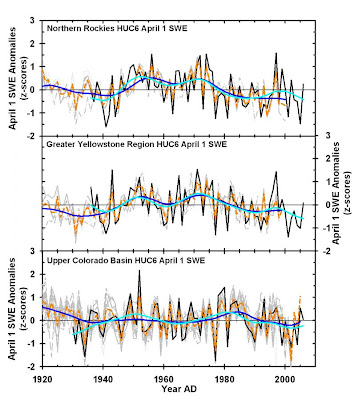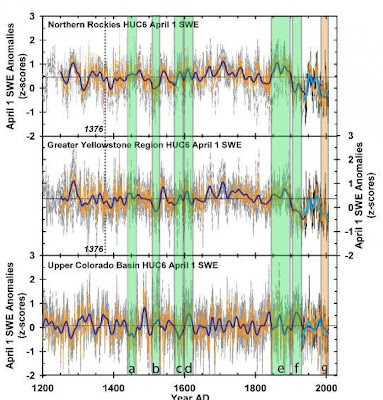
I took a look at the latest
snowpack report today and was stunned!
As reported by the U.S. Department of Agriculture's Natural Resources Conservation Service the Olympic Mt.
snowpack (actually the total snow water equivalent--
SWE--of the current
snowpack)
was nearly four hundred times normal. Here is the official map (click to on it to enlarge):

Most of the
snowpack measurements in Washington were 200 to 600% of normal, and Oregon and Idaho had similar values--some into the thousands of % of normal. Montana has several basins into the thousands.
Now having
snowpacks tens or hundreds of times normal does not mean we had tens or hundreds of times more rain or snow last winter; normally there is very little
snowpack left this late in the season and thus having a substantial
snowpack can give you very large numbers (where snow is usually melted off completely you could get infinity!). But no matter how you cut it, we have an amazing
snowpack for this late in the season.
Why so unusual? We started with a very good spring
snowpack after a cool, wet La Nina winter, and one of the coolest springs (now summer) on record is allowing the
snowpack to remain. To illustrate, lets look at the temperatures at Stampede Pass at roughly 4000 ft in the Washington Cascades over the past four weeks and compare those temperatures against the normal highs and lows:

Only a a handful of days got above normal and most never even got close to the normal highs. On many days the high temperatures barely reached the average lows!
This kind of substantial late season
snowpack provides a serious flooding risk, so it is good that we are not warming up quickly. A major heat wave situation would cause a number of rivers to overflow their banks--particularly overthe eastern slopes of the Cascades. I should note that the northern Rockies have a huge
snowpack as well and the melting of that snow is resulting in historic flooding over the Dakotas right now.
We should not forget that the large number of dams on the Columbia not only provide hydroelectric power and water for irrigation, but they serve a flood control role. This week I was talking to a meteorologist at the Bonneville Power Administration and he said that their calculations indicated that without the dams, Portland would have had substantial flooding starting two weeks ago. Before the dams went in, major springtime floods were not unusual on the Columbia. The most dramatic example was the
Vanport, Oregon flooding in 1948.
Vanport was a town on the Columbia River near Portland that was flooded and essentially destroyed, killing 15 and leaving 6000 homeless (see pictures
bel0w). A huge
snowpack had built up in the mountains, and warm temperatures leading up to the Memorial Day weekend initiated a surge of
floodwaters moving down the Columbia--with few dams to intercede and stop the waters (check my book for more details on this event)


So we should hope for a slow warm up--and there will be plenty of water for irrigation and hydroelectric generation this summer.
The irony of the current situation is that it not only is good for
hydropower but for wind energy as well. As shown in visible satellite imagery, almost every day this spring (like today--see below), the western side has been inundated with clouds and cool air,

while the eastern part of the state is warmer and sunny. Cool air is associated with high pressure, warm air with low pressure--and thus we have a large difference in pressure across the Cascades. Air rushes through the Columbia Gorge and through gaps in the Cascades, right into the major
windfarm projects. Thus, this is a very good year for
wind power as well.
The problem, as discussed in the press, is that there is not enough transmission capacity for all this clean, renewable power, and as as result the wind farm folks have been forced to feather their turbines, losing large amounts of money in the process. Not good for wind farm owners, probably really good for lawyers.






















































